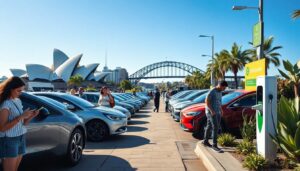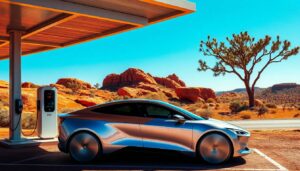Introduction
Electric vehicles (EVs) are changing how Australians move around. More people are choosing EVs as they become better and cheaper. The push for cleaner air and less reliance on fossil fuels makes EVs a smart choice. Governments are creating new rules, the market is growing fast, and drivers are more interested in electric cars than ever before. These trends show that EVs are here to stay in Australia.
The Current State of Electric Vehicles in Australia
Market Penetration and Sales Data
In recent years, EV sales in Australia have surged. Last year, over 30,000 electric cars were sold, a big jump from just a few thousand in 2019. Electric vehicles now make up around 4% of all new car sales. Compare that to traditional petrol and diesel cars, which still dominate, but EVs are catching up fast. Industry experts expect this growth to speed up in the coming years.
Government Policies and Incentives
Australia’s federal and state governments have introduced helpful policies to boost EV use. Some states, like Victoria and South Australia, offer rebates and discounts on registration costs. The federal government is also discussing tax breaks for EV buyers. These policies help make EVs more affordable and encourage more people to switch. Plus, they support the building of charging stations across cities and rural areas, making EV driving easier.
Consumer Perception and Adoption Challenges
Many Australians are open to EVs, but some worry about costs and how far they can travel on a single charge. Range anxiety remains a top concern, especially in rural areas. Still, interest is growing among early adopters, mainly younger drivers and city dwellers. Education campaigns also help reduce misconceptions about electric cars and their reliability.
Infrastructure Development and Charging Networks
Charging Station Expansion
Australia is adding more charging stations across the country. Major cities like Sydney, Melbourne, and Brisbane now have plenty of fast chargers. However, rural and remote regions still lack good charging options. Expanding this network is key to encouraging larger EV adoption in all areas.
Types of Charging Stations
There are three main types of chargers:
- Level 1: Slow charging, suitable at home using standard outlets
- Level 2: Faster, often used at public charging points and workplaces
- Fast chargers: Provide 80% battery charge in 30 minutes, ideal for long trips
Each has its role. Fast chargers are great for quick stops, while Level 1 and 2 chargers suit everyday use.
Future Infrastructure Projects
Looking ahead, more ultra-fast chargers are planned, making long trips easier and faster. Government investments aim to triple the number of charging stations in the next five years. Smart grid technology and renewable energy integration are also in the pipeline, making EV charging cleaner and more efficient.
Technological Advances and Vehicle Options
Latest EV Models Available in Australia
Leading brands now offer a range of electric cars:
- Tesla Model 3 and Model Y — long-range, high-tech sedans
- Hyundai Kona Electric — compact and affordable
- Kia EV6 — stylish SUV with impressive range
- Ford Mustang Mach-E — sporty and innovative
Prices vary, from budget-friendly options around $50,000 to luxury models over $100,000. These cars come with features like advanced safety systems and connected tech, making EVs more attractive than ever.
Battery Technology and Range Improvements
Battery tech keeps improving, letting cars go farther on a single charge. Recently, solid-state batteries promise even better range and durability. Next-gen batteries could soon allow EVs to travel 500 km or more before needing a recharge, easing worries about driving long distances.
Sustainable and Zero-Emission Driving
Electric cars produce no tailpipe emissions, helping reduce air pollution. When charged with renewable energy, EVs can become truly carbon-free. Many cities are also introducing electric buses and delivery vehicles, pushing toward cleaner public transport.
Economic and Environmental Impact
Cost of Ownership and Incentives
While EVs often cost more upfront, savings come from lower fuel and maintenance bills. Incentives, like rebates and tax breaks, help cut the initial price. Over time, EV owners often spend less compared to traditional car owners, making them a better long-term investment.
Environmental Benefits
Switching to EVs cuts greenhouse gases and improves air quality. Australia’s climate goals aim for zero emissions by 2050, and EV adoption is a key part of that strategy. Cleaner transportation means healthier communities and a safer environment.
Job Creation and Industry Growth
As the EV industry grows, so do jobs. From manufacturing batteries to building charging stations, new opportunities appear. Supporting local industries means more jobs in regional areas and a boost for Australia’s economy.
Challenges and Opportunities Ahead
Barriers to Widespread Adoption
High upfront costs still stop many from buying EVs. Improving access to fast chargers in less populated areas is also a challenge. Public awareness campaigns and education can help address misconceptions and show EVs’ true value.
Policy Recommendations and Industry Support
Australia can learn from countries like Norway and the Netherlands, where EVs are common. Public-private partnerships and clear policies will help speed up the shift. Incentives, infrastructure, and consumer education are all needed to make electric cars the norm.
Opportunities for Innovation and Growth
The future holds many exciting prospects. Combining autonomous driving with EVs could revolutionize transport. Smart city projects and mobility services could make travel even easier and greener. Australia has the chance to lead in electric vehicle tech and shape a cleaner future.
Conclusion
Australia is making steady progress in the shift toward electric vehicles. Improved charging infrastructure, innovative technology, and supportive policies are driving growth. Yet, challenges remain, especially in rural areas. Everyone—government, industry, and consumers—must work together to speed up this change. The benefits for the environment, economy, and quality of life make the switch worth it. Now is the time to embrace electric vehicles and steer toward a sustainable future for Australia.




